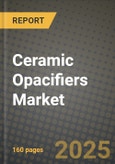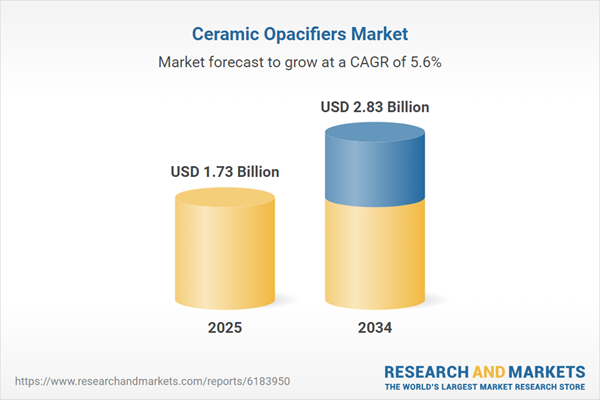Ceramic Opacifiers Market
The ceramic opacifiers market spans zirconium-based systems (zircon, zirconia, zircon silicate), tin oxide, zinc oxide, antimony-based and emerging mixed-metal formulations used to deliver whiteness, opacity, and defect masking in wall/floor tiles, sanitaryware, tableware, frits & glazes, enamel coatings, and advanced technical ceramics. Demand is propelled by sustained urban housing, renovation cycles, shift to digitally printed tiles that still require controlled background opacity, and premium sanitaryware aesthetics. Zircon remains the workhorse for high-opacity glazes and engobes due to refractive index and chemical stability, while tin oxide leads in specialty tableware and art glazes where warm tonality and food-contact traditions persist. Cost and color-physics optimization drive formulators to blend opacifiers with alumina/zirconia toughening fillers or hollow/lightweight opacifying agents to reduce density and firing load. Digital decoration (inkjet) pushes fine, narrow PSD opacifiers that disperse cleanly, avoid nozzle wear, and interact predictably with stains/pigments. Energy transitions in kilns (natural gas → electric/hydrogen/hybrids) and lower firing curves are reshaping frit chemistry, pushing opacifiers to maintain scattering power at reduced viscosity/temperature. Sustainability pressures elevate recycled content, beneficiation of off-grade zircon sands, and low-dust granulation for worker safety. Supply dynamics hinge on zircon sand mining, milling capacity, and regional beneficiation near tile clusters; substitution strategies (e.g., mixed-phase calcines, tin-zircon blends) manage price spikes. Winning suppliers pair consistent whiteness/opacity at lower dosages with rheology-stable dispersions, digital-print compatibility, and application labs that tune recipes by body, frit, and kiln profile.Ceramic Opacifiers Market Key Insights
- Zircon remains the backbone: High refractive index and chemical inertness make zircon/zircon silicate the default for tile engobes and glossy/matt glazes; nano-tailored grades lift scattering efficiency, letting plants cut dose without sacrificing coverage.
- Tin oxide holds niche leadership: In tableware and heritage glazes, SnO₂ delivers warm, dense opacity and acid resistance; cost and supply lead formulators to partial substitution with zircon blends or alumina modifiers when aesthetics allow.
- Digital printing changes the rules: Fine, de-agglomerated opacifiers with narrow PSD and low abrasion protect inkjet hardware; controlled interaction with chromophores preserves color gamut and avoids haloing/blooming under transparent inks.
- Engobe engineering saves costs: High-opacity engobes let factories use lower-grade bodies while keeping surface aesthetics; optimized particle packing and frit synergy reduce total opacifier loading and pinhole risk.
- Lower-temperature firing challenge: As kilns decarbonize and cycles shorten, opacifiers must remain active at lower melt viscosities; mixed-phase zirconia-silicate and reactive calcines sustain scattering at gentler profiles.
- Rheology and dispersion are make-or-break: Surface-treated powders and dust-free granules stabilize glaze viscosity, improve pumpability, and reduce filter clogs - key for high-throughput spray lines and digital topcoats.
- Defect control under pressure: Formulations tuned for CO₂ release and moisture windows cut crawling, pinholes, and fisheyes; robust opacifiers tolerate body salts and flux variations typical of recycled raw-material streams.
- Sustainability becomes specification: Low-dust handling, reusable bags, beneficiation of tailings, and mass-balance accounting for recycled inputs differentiate in ESG audits without compromising whiteness.
- Localization buffers risk: Milling/compaction close to tile belts (e.g., APAC clusters) ensures tight QC and just-in-time supply; technical centers that co-develop glaze/engobe fit-for-plant win stickier share.
- TCO beats price-per-kilo: Plants choose lower-dose, higher-scatter grades that reduce energy, rework, and scrap; suppliers who provide process audits and inkjet-safe certifications unlock multi-year supply positions.
Ceramic Opacifiers Market Reginal Analysis
North America
Renovation-driven tile demand and premium sanitaryware sustain consumption of high-brightness zircon opacifiers. Domestic plants emphasize inkjet compatibility, low-dust handling, and consistent whiteness across short runs. Energy and labor costs push interest in lower-dose, higher-scatter grades and rheology-stable dispersions to minimize downtime. Import reliance for zircon favors suppliers with transparent provenance and safety stock strategies.Europe
Strict environmental standards and energy costs accelerate kiln optimization and lower-temperature glazes; opacifiers must retain performance under shortened cycles. Tableware and enamelware maintain niches for tin oxide with partial zircon substitution. Plants prioritize dust-free compacts, closed-loop handling, and EHS documentation. Technical support for digital lines and defect diagnostics (pinhole/crawl) is a procurement differentiator.Asia-Pacific
The world’s largest tile clusters drive volume, with strong pull for cost-effective zircon grades and localized milling/beneficiation. Rapid digital-print adoption favors fine, low-abrasion opacifiers. Price volatility in zircon sand encourages blend optimization and reactive calcines. Suppliers with regional tech centers offering engobe/glaze tuning and quick QC turnaround gain durable share.Middle East & Africa
Construction booms and large-format tiles uplift demand for high-opacity engobes to mask variable bodies. Plants seek robust, easy-to-spray glazes resilient to high ambient dust and temperature. Reliable logistics, dust-controlled packaging, and technical commissioning support matter, while sanitaryware producers value premium whiteness with acid/alkali resistance.South & Central America
Tile manufacturing hubs focus on cost and line uptime - favoring opacifiers that deliver dose reduction, stable rheology, and fewer reworks. Regional supply and toll milling reduce FX exposure and lead times. Digital-print lines expand, raising the bar on PSD control and ink/pigment compatibility; vendors with in-plant trials and operator training earn preference.Ceramic Opacifiers Market Segmentation
By Product
- Zirconium Silicate
- Zirconium Dioxide
- Others
Key Market players
Vibrantz Technologies (Ferro), Torrecid Group, Altadia Group (Esmalglass-Itaca), Colorobbia Group, Imerys, Sibelco, Saint-Gobain ZirPro, The Chemours Company, Tronox, Venator Materials, Kronos Worldwide, Iluka Resources, Tosoh Corporation, Daiichi Kigenso Kagaku Kogyo (DKKK), Zircomet LimitedCeramic Opacifiers Market Analytics
The report employs rigorous tools, including Porter’s Five Forces, value chain mapping, and scenario-based modelling, to assess supply-demand dynamics. Cross-sector influences from parent, derived, and substitute markets are evaluated to identify risks and opportunities. Trade and pricing analytics provide an up-to-date view of international flows, including leading exporters, importers, and regional price trends.Macroeconomic indicators, policy frameworks such as carbon pricing and energy security strategies, and evolving consumer behaviour are considered in forecasting scenarios. Recent deal flows, partnerships, and technology innovations are incorporated to assess their impact on future market performance.
Ceramic Opacifiers Market Competitive Intelligence
The competitive landscape is mapped through proprietary frameworks, profiling leading companies with details on business models, product portfolios, financial performance, and strategic initiatives. Key developments such as mergers & acquisitions, technology collaborations, investment inflows, and regional expansions are analyzed for their competitive impact. The report also identifies emerging players and innovative startups contributing to market disruption.Regional insights highlight the most promising investment destinations, regulatory landscapes, and evolving partnerships across energy and industrial corridors.
Countries Covered
- North America - Ceramic Opacifiers market data and outlook to 2034
- United States
- Canada
- Mexico
- Europe - Ceramic Opacifiers market data and outlook to 2034
- Germany
- United Kingdom
- France
- Italy
- Spain
- BeNeLux
- Russia
- Sweden
- Asia-Pacific - Ceramic Opacifiers market data and outlook to 2034
- China
- Japan
- India
- South Korea
- Australia
- Indonesia
- Malaysia
- Vietnam
- Middle East and Africa - Ceramic Opacifiers market data and outlook to 2034
- Saudi Arabia
- South Africa
- Iran
- UAE
- Egypt
- South and Central America - Ceramic Opacifiers market data and outlook to 2034
- Brazil
- Argentina
- Chile
- Peru
Research Methodology
This study combines primary inputs from industry experts across the Ceramic Opacifiers value chain with secondary data from associations, government publications, trade databases, and company disclosures. Proprietary modeling techniques, including data triangulation, statistical correlation, and scenario planning, are applied to deliver reliable market sizing and forecasting.Key Questions Addressed
- What is the current and forecast market size of the Ceramic Opacifiers industry at global, regional, and country levels?
- Which types, applications, and technologies present the highest growth potential?
- How are supply chains adapting to geopolitical and economic shocks?
- What role do policy frameworks, trade flows, and sustainability targets play in shaping demand?
- Who are the leading players, and how are their strategies evolving in the face of global uncertainty?
- Which regional “hotspots” and customer segments will outpace the market, and what go-to-market and partnership models best support entry and expansion?
- Where are the most investable opportunities - across technology roadmaps, sustainability-linked innovation, and M&A - and what is the best segment to invest over the next 3-5 years?
Your Key Takeaways from the Ceramic Opacifiers Market Report
- Global Ceramic Opacifiers market size and growth projections (CAGR), 2024-2034
- Impact of Russia-Ukraine, Israel-Palestine, and Hamas conflicts on Ceramic Opacifiers trade, costs, and supply chains
- Ceramic Opacifiers market size, share, and outlook across 5 regions and 27 countries, 2023-2034
- Ceramic Opacifiers market size, CAGR, and market share of key products, applications, and end-user verticals, 2023-2034
- Short- and long-term Ceramic Opacifiers market trends, drivers, restraints, and opportunities
- Porter’s Five Forces analysis, technological developments, and Ceramic Opacifiers supply chain analysis
- Ceramic Opacifiers trade analysis, Ceramic Opacifiers market price analysis, and Ceramic Opacifiers supply/demand dynamics
- Profiles of 5 leading companies - overview, key strategies, financials, and products
- Latest Ceramic Opacifiers market news and developments
Additional Support
With the purchase of this report, you will receive:- An updated PDF report and an MS Excel data workbook containing all market tables and figures for easy analysis.
- 7-day post-sale analyst support for clarifications and in-scope supplementary data, ensuring the deliverable aligns precisely with your requirements.
- Complimentary report update to incorporate the latest available data and the impact of recent market developments.
This product will be delivered within 1-3 business days.
Table of Contents
Companies Mentioned
- Vibrantz Technologies (Ferro)
- Torrecid Group
- Altadia Group (Esmalglass-Itaca)
- Colorobbia Group
- Imerys
- Sibelco
- Saint-Gobain ZirPro
- The Chemours Company
- Tronox
- Venator Materials
- Kronos Worldwide
- Iluka Resources
- Tosoh Corporation
- Daiichi Kigenso Kagaku Kogyo (DKKK)
- Zircomet Limited
Table Information
| Report Attribute | Details |
|---|---|
| No. of Pages | 160 |
| Published | November 2025 |
| Forecast Period | 2025 - 2034 |
| Estimated Market Value ( USD | $ 1.73 Billion |
| Forecasted Market Value ( USD | $ 2.83 Billion |
| Compound Annual Growth Rate | 5.6% |
| Regions Covered | Global |
| No. of Companies Mentioned | 15 |









